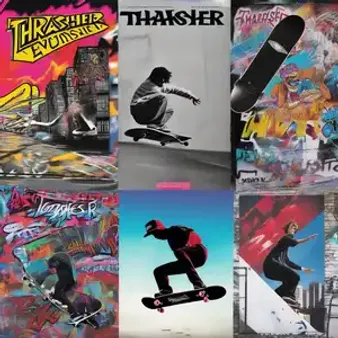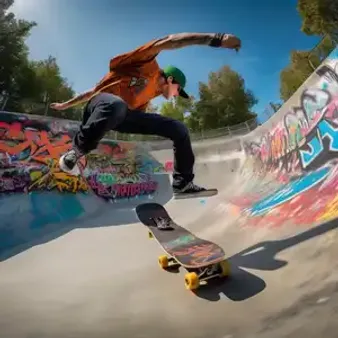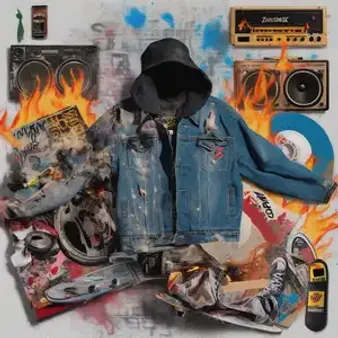Table of Contents
kizworld takes you on a journey through the vibrant and rebellious world of thrasher magazine covers. These iconic images have captured the spirit of skateboarding for decades, showcasing incredible talent, daring stunts, and the raw energy of the sport. From the early days of punk rock influence to the modern era of digital art, Thrasher Magazine covers have become a powerful symbol of skateboarding culture, inspiring generations of skaters and artists alike.
Feature | Description |
|---|---|
History | Thrasher magazine covers have documented the evolution of skateboarding since the 1980s. |
Iconic Designs | Memorable covers featuring legendary skaters, daring stunts, and groundbreaking photography define the magazine's aesthetic. |
Art and Design | Covers showcase a range of styles, from punk rock aesthetics to modern digital art, reflecting skateboarding's diverse influences. |
Cultural Impact | Thrasher magazine covers have transcended skateboarding, influencing fashion, music, and art, becoming a symbol of rebellious youth culture. |
The History of Thrasher Magazine Covers
Imagine a world where skateboarding wasn't just a hobby, but a rebellious act, a statement of individuality. That's the world Thrasher Magazine stepped into back in 1981. Founded by Fausto Vitello and Eric Swenson, Thrasher wasn't just another magazine; it was a voice for the raw, untamed spirit of skateboarding. And what better way to capture that spirit than through their covers?
Early Thrasher covers were like a punk rock concert on paper. Gritty, in-your-face photography of skaters pulling off crazy stunts, often shot in black and white, became their signature style. You could almost hear the roar of the crowd and the screech of wheels through those images. They weren't afraid to showcase the danger and the spills, the real side of skateboarding that other magazines glossed over. It was this raw honesty that resonated with skaters and turned Thrasher into a cult classic.
Decade | Style |
|---|---|
1980s | Gritty, black and white photography, punk rock aesthetic |
1990s | Bold colors, experimental layouts, emergence of street skating |
2000s | Digital art, photo manipulation, focus on individual skater personalities |
As skateboarding evolved, so did Thrasher's covers. The 90s saw a burst of color and more experimental layouts. Think vibrant graffiti art, distorted perspectives, and the rise of street skating dominating the covers. It was like the magazine was mirroring the evolution of the sport itself, from empty pools to urban landscapes. This era also saw the rise of iconic skaters like Tony Hawk and Danny Way gracing the covers, further solidifying Thrasher's position as the definitive skateboarding magazine. If you're interested in learning how to skateboard, you can check out our guide on how to get started with skateboarding.
The History of Thrasher Magazine Covers
Iconic Thrasher Magazine Covers
Some Thrasher covers are so legendary, they're practically skateboarding history in picture form. Take the May 1987 cover with Tony Alva soaring over a massive ramp. It's pure adrenaline frozen in time, and it perfectly captures the "go big or go home" spirit of skateboarding. Then there's the iconic "Flame Boy" cover from July 1989, a fiery, punk-inspired design that screams rebellion and nonconformity. It's no surprise that this cover became a symbol for the magazine itself. These covers weren't just about cool tricks; they were about capturing the soul of skateboarding.
Iconic Thrasher Magazine Covers
The Art and Design of Thrasher Magazine Covers
Thrasher Magazine covers are like mini masterpieces. They're not just photos of skaters doing tricks; they're bursting with creativity and attitude! Think bold colors, crazy fonts, and graphics that look like they jumped straight out of a skater's sketchbook. It's like each cover is trying to outdo the last one, pushing the boundaries of what a magazine cover can be.
One thing that makes Thrasher covers so cool is how they capture the raw energy of skateboarding. It's like you can almost feel the wind whipping past you and hear the clatter of the board as you stare at the image. They're not afraid to show the scrapes, the falls, the real grit that comes with pushing your limits on a skateboard. It's this authenticity that makes them so relatable, even if you've never set foot on a skateboard. If you're interested in skateboarding, check out our guide on how to get started with skateboarding.
A Fusion of Skate and Punk
Imagine a mosh pit at a punk rock concert – that's the kind of energy Thrasher covers bring to the table. They've got this rebellious, DIY aesthetic that's all about breaking the rules and doing things your own way. They're not trying to be polished or perfect; they're raw, edgy, and full of life, just like skateboarding itself.
Thrasher covers often feel like a collaboration between the magazine and the skaters themselves. It's like the skaters are saying, "This is who we are, this is what we do," and Thrasher is blasting it out to the world through their covers. It's a powerful combination that has made Thrasher a cultural icon, inspiring not just skaters, but artists, musicians, and anyone who embraces a little bit of rebellion. To see how skateboarding has influenced fashion, check out our article on skateboarding apparel.
Element | Impact |
|---|---|
Bold Colors | Grab attention and reflect the energetic nature of skateboarding. |
Unique Fonts | Add personality and style, often inspired by punk rock aesthetics. |
Dynamic Graphics | Capture the movement and excitement of skateboarding, often featuring illustrations or photo manipulations. |
The Art and Design of Thrasher Magazine Covers
The Cultural Impact of Thrasher Magazine Covers
From Skate Parks to the Mainstream
Thrasher magazine covers didn’t just stay in the skate parks; they went mainstream! Think about it: you've probably seen those iconic Thrasher designs on T-shirts, backpacks, and even phone cases. People who've never even touched a skateboard rock the Thrasher logo. It's like a badge of cool, a nod to rebellious counter-culture. Musicians, artists, and fashion designers have all drawn inspiration from Thrasher's bold graphics and DIY aesthetic.
Remember that time you saw a rock star wearing a Thrasher shirt on stage, or that cool mural in your town that had that unmistakable Thrasher style? That's the impact of these covers. They've become a symbol of individuality and nonconformity, a way for people to express their own unique style. It's proof that Thrasher magazine covers have become more than just magazine art; they've become a part of our cultural landscape.
A Symbol of Rebellion and Authenticity
Thrasher magazine covers are all about keeping it real. They don't shy away from the scrapes and bruises, the sweat and tears that come with pushing your limits on a skateboard. This authenticity makes them super relatable, even if you've never stepped on a skateboard. It's like they're saying, "Yeah, life can be tough, but you gotta keep pushing, keep going for it."
This message of resilience and determination has resonated with people from all walks of life - artists, musicians, and anyone who feels like they don't quite fit in with the mainstream. Thrasher magazine covers give them a voice, a sense of belonging, and a reminder that it's okay to be different, to embrace your inner rebel. To see how skateboarding has influenced another aspects of culture, check out our article on skateboarding movies and documentaries.
- Fashion: Thrasher's iconic logo and graphics have become a streetwear staple, appearing on clothing, accessories, and footwear.
- Music: Numerous bands and musicians have incorporated Thrasher imagery and aesthetics into their merchandise, album art, and music videos.
- Art: Thrasher's bold graphics and rebellious spirit have inspired street artists, illustrators, and graphic designers, influencing urban art and design trends.
The Cultural Impact of Thrasher Magazine Covers
Final Thought
Thrasher Magazine covers are more than just magazine art; they are a visual chronicle of skateboarding's evolution, capturing its spirit, its heroes, and its enduring impact on popular culture. These covers continue to inspire, provoke, and ignite the passion for skateboarding, reminding us that this is more than just a sport - it's a way of life.